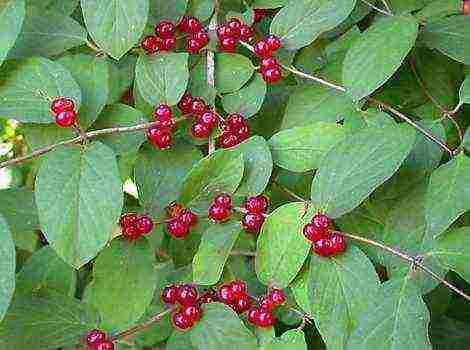Content
- 1 History of appearance
- 2 The best varieties
- 3 Growing features
- 4 Advantages and disadvantages
- 5 Video "Kishmish grapes"
- 6 Description of the best varieties with photos
- 7 Advantages and disadvantages
- 8 Features of planting and care
- 9 Diseases and pests
- 10 Kishmish grapes: video
- 11 Reviews
- 12 How and where was the variety obtained
- 13 General description
- 14 Brush varieties
- 15 Berries of the variety kishmish "century": description
- 16 Landing features
- 17 Watering the grapes
- 18 How to fertilize
- 19 Pruning bushes
- 20 Protection against fungus and other diseases
- 21 The opinion of summer residents about the variety
- 22 Instead of a conclusion
Kishmish grapes are a whole series of seedless hybrids. They make raisins, excellent juices, and amazing wine. In books about tasty and healthy food, you will find many recipes for dishes where raisins are, if not the main, then an additional ingredient. It is even used in cosmetology!
History of appearance
Scientists cannot name the exact date of the appearance of this grape. The plant is believed to have originated from a natural mutation. And already thanks to the painstaking work of breeders, varieties without seeds appeared, including green, pink and white raisins.
The best varieties
Moldavian
This variety ripens for quite a long time - 150–160 days. Fruits appear 3 years after planting. September-October is the time when you can enjoy Moldavian raisins. The fruits are sweet, seedless, and have an exquisite taste.
High-yielding variety. Up to 50 kg of fruit can be removed from one bush. Moldavian perfectly tolerates transportation and can be stored for up to six months. However, the variety has disadvantages: in addition to long ripening, it is highly susceptible to diseases and does not tolerate frost well.
Radiant
It is a high yielding variety with large to medium sized berries. It was called radiant because when the grapes are ripe, its fruits let the rays of sunlight pass through, creating the effect of "radiance". The cone-shaped clusters can be up to 40 cm long and weigh almost 1 kg. Fragrant berries of bright pink color with dense flesh have a slight nutmeg flavor. This variety not only has a high yield, but also tolerates transportation well and is well stored. "Radiant" requires careful care, as it is unstable to some diseases.
This grape needs abundant watering. Sometimes you need to pour up to 9 buckets of water under one bush. One of the advantages of the variety is its early ripening (125–130 days). The disadvantages include low frost resistance. The bushes are planted in spring or autumn at a distance of 2.5 m from each other, as the grapes love space. To protect from cold weather, the bushes are covered with sawdust, sometimes peat.
Hungarian
The Hungarian variety is especially popular with us. There is no person who would not like to feast on these juicy and fleshy fruits. This green grape is considered early and has a delicate nutmeg flavor. Hungarian boasts a high yield. If you overexpose it on the bushes, the clusters will be medium-sized, and seeds may appear in the berries.
Find
This variety is frost-resistant. It can withstand temperatures as low as -23 ° C. The find was obtained by crossing the Talisman and Radiant grapes. In mid-August and early September, you can collect massive bunches with dense, sweet pink pulp with a nutmeg aroma. The variety ripens within 116-125 days (average), has a high yield and is resistant to many diseases, including fungal ones.
Rusball improved
This form was developed in Russia. The improved bush of Rusbol is large, the clusters are large (over 1.5 kg).Berries weighing 2–2.5 g contain 20–22% sugar. The first fruits are harvested in the second year after planting. The variety is resistant to mildew, is not afraid of severe frosts, and perfectly withstands transportation.
Rylines pink seedlings
This grape came to us from the USA. The bush is tall, the bunches have a weight of 100 to 300 g. Pink berries are pleasant to the taste and exude a labrus aroma. The sugar content reaches 24%. The grapes are unpretentious, frost-resistant, but high humidity is detrimental to the harvest.
Jupiter
And again we have an American guest. On a medium-sized bush, half-kilogram clusters grow. Large oval berries have a deep pink color, and when fully ripe, they can reach dark blue. The fruit has a light nutmeg flavor. The first fruits usually appear 1–2 years after planting. This variety has an average resistance to fungal diseases, so the gardener will have to take care of protecting the grapes from infections.
Novocherkassk
The variety brings stable yields, it is not afraid of severe frosts, and high resistance to fungal diseases is also observed. But for all its merits, the plant requires some care: a garter, shelter for the winter. The bush begins to bear fruit in the second or third year after planting.
Growing features
Growing this wonderful variety in their vineyards is the dream of most gardeners, because there are no seeds in all varieties. Kishmish requires the same care as other grape varieties, namely pruning, watering, fertilizing and pest control. In winter, the raisins must be insulated, and in the spring the bushes must be treated with chemicals.
Bushes are located at a distance of 2 m from each other. Prune the vine during the first year after planting, removing all weak shoots. To avoid potassium starvation, you need to make sure that the bush is not too overwhelmed. During the summer, the bushes need to be watered intensively. A couple of weeks before picking berries, watering is halved.
Advantages and disadvantages
Kishmish grape varieties have many useful properties, but they also have a number of disadvantages. The advantages include:
- quickly saturate;
- help to strengthen the immune system;
- remove toxins;
- prevent the development of thrombophlebitis;
- give a noticeable rejuvenating effect;
- increase the level of hemoglobin;
- reduce the risk of atherosclerosis.
And this is not a complete list of useful properties of the raisins grape variety. But some contraindications should also be noted. This product should not be consumed by those who suffer from:
- pancreatitis;
- stomach ulcers;
- gallbladder disease.
Kishmish is rich in sugars, so it is better to refrain from using it for patients with diabetes mellitus.
This grape also negatively affects the tooth enamel, so after it you need to rinse your mouth with clean water.
Video "Kishmish grapes"
From this video you will learn how to properly grow raisins grapes.
.
Since time immemorial, grapes have been read as an exquisite, tasty and healthy fruit. For the first time mankind started to grow it. Now the seedlings of such a plant easily take root in all kinds of territories of the world. Kishmish grapes are no exception, the variety of which allows the product to be used in many industries (for making wine, jam, fruit drinks, etc.).
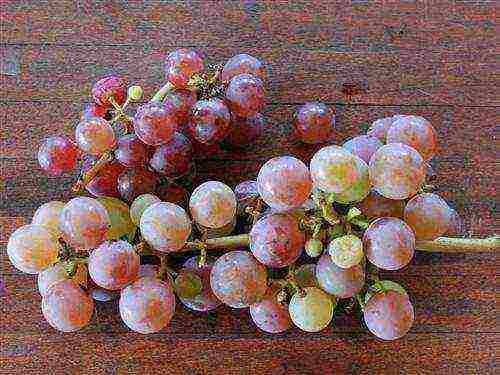
Rylines pink seedlings - American variety of raisins
History of origin
The grape is a perennial plant. Until now, no one knows when and where the cultivation of this plant with exquisite fruits began. Scientists claim that the fruit began to grow 60,000 BC, because all kinds of wines were served at the Egyptians' feasts, which means the presence of winemaking at that time.
Over the centuries, grapes have attracted human attention, grown in all kinds of corners of the earth, where there were suitable conditions for this. This is a plant to which poems, legends, songs, proverbs and sayings are dedicated.If you believe one legend, then during the global flood, when mankind perished, and Noah and his family were saved on the ark, he became the ancestor of a new generation and gave people grapes.
According to legend, Noah landed on Mount Ararat and released a goat ashore, she went in search of food. She found a miracle - a climbing bush with juicy leaves. When the goat ate enough leaves, it got drunk, bleated, jumped and butted. Noah became interested in this plant and made a plantation. According to legend, the Transcaucasia and the Mediterranean countries became the birthplace of grapes.
The grapes were created by natural mutation through vegetative propagation. Later, due to selection, many varieties with developed seeds appeared. Every year, such grapes are popular, as they contain many vitamins and minerals.

According to the legend, having descended Mount Ararat, Noy found grapes there.
Variety
The best varieties of berries:
- Moldavian.
- Radiant.
- Hungarian.
- Find.
- Rusball improved.
- Rylines pink seedlings.
- Jupiter.
- Novocherkassky.
Kishmish Moldavian
From the description made by scientists, it is clear that this variety ripens relatively late (150-160 days). It is characterized as vigorous, with ripening shoots with large clusters. The plant begins to bear fruit 3 years after planting. Withstands frosts down to -18. Harvested in September - October. Up to 50 kg of berries are usually removed from one bush. The crop is able to withstand transportability and can be stored for up to 180 days.
Advantages of the variety:
- Refined taste.
- Sugary.
- Lack of seeds.
- High productivity.
- Shelf life.
Flaws:
- non-frost-resistant;
- susceptible to many diseases;
- ripening period.
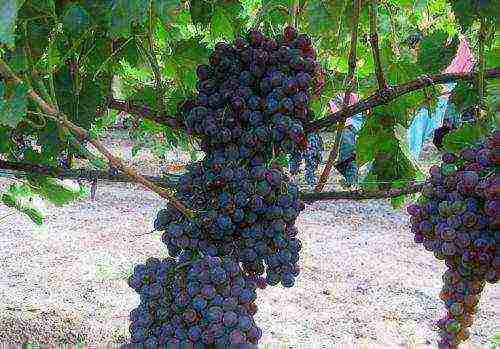
Moldavian kishmish is distinguished by its sweetness and good transportability.
Radiant kishmish
It is a high quality fruit variety. The bush is whimsical to care for, because disease resistance is weak. Easily transfers storage and transportation. Bunches of grapes grow very large, up to 1 kg. Ripen within 125-130 days. The plant does not withstand frost, loves space (distance between bushes is 2-2.25 m).
Thanks to the description of scientists, it became clear that this variety sits not only in spring, but also in autumn. Before the onset of cold weather, the bushes are covered with sawdust, peat, and possibly soil. To avoid overloading the bushes, additional supports are required. The plant requires careful and abundant watering, you need 6-9 buckets per 1 piece. Plus, timely feeding with nitrogenous fertilizers is necessary before flowering. Weak shoots have to be removed to ensure yields.
The advantages of this variety:
- ripens early;
- high productivity;
- transportability.
Flaws:
- Harvest too large (extra care).
- Does not tolerate frost.
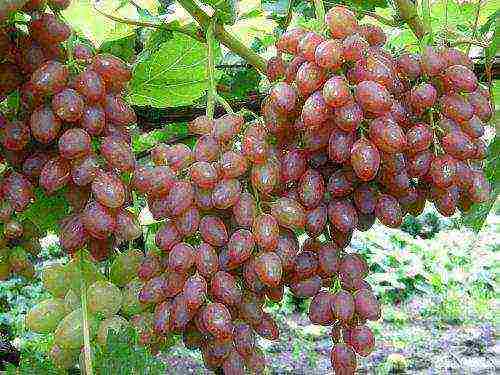
Radiant kishmish is a very productive early variety
Hungarian Kishmish
This variety ripens early (110-115 days), the fruits are famous for their incomparable taste. When ripe, the berry can remain on the bushes for up to 2 months. The plant is unpretentious, does not require special care, specific planting dates (this is confirmed by the description carried out by scientists). The seedlings do not need to be covered and hidden from the cold and low temperatures.
Distinctive features are usually called:
- resistance to the effects of fungal organisms;
- ability to withstand frosts down to minus 26 ° C;
- the ability to grow in any regions of the vast planet;
- digestibility by children, thanks to the precise structure of the berry;
- transportability.
Flaws:
- It quickly deteriorates when it is on the bushes for a long time.
- The presence of seeds, rudiments.
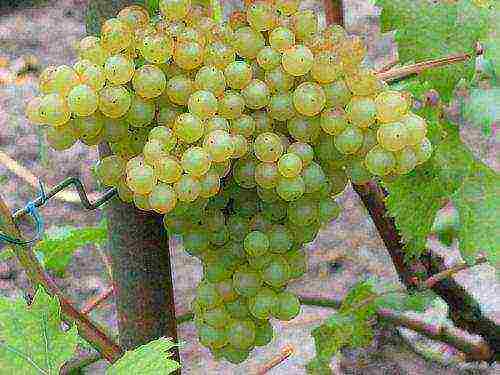
Hungarian kishmish must be removed from the bush immediately after ripening
Kishmish Nakhodka
The find belongs to the category of very early table varieties. Brings a large harvest, the weight of one bunch reaches 1.5 kg. Plants can withstand frosts down to minus 23 °. Grapes prefer to grow in fertile soils.You need to plant so that there is one and a half to two meters between the plants.
Advantages of the variety:
- withstands frost;
- unpretentious;
- brings a large harvest.
Although the description is for informational purposes, it is worth pointing out the disadvantages:
- Does not tolerate excess feed.
- You need to grow in a sunny area.
Rusball improved
Description of the variety: a large bush with large clusters up to 1.5 kg. The plant is high-yielding. Ripens very early (105-115 days).
This grape variety does not require careful maintenance, does not have a specific planting time, and with careful care and the use of fertilizers, huge bunches can ripen (more than 1.5 kg).
Distinctive characteristics of this type are:
- frost resistance (up to minus 25 ° С);
- the possibility of growing in all kinds of regions, pickiness;
- yield;
- the fruits are tolerated.

Superior Rusball gives very large clusters
Rylines pink seedlings
The description of this variety is as follows: the States serve as the homeland of such a creation. The bushes look vigorous with small berries. Bushes are high-yielding, ripen early, in 105-115 days. You need to plant seedlings in a lighted place, because they grow on any soil, except for a very moist one.
This variety of grapes perfectly tolerates frosts (up to minus 27 ° C), is resistant to diseases and many pests (mildew). An important characteristic is that the berries, after ripening, can be on the bushes for a long time. The fruit of the grapes has a pleasant taste. It is important to note that with excessive moisture, the berries can crack.
Kishmish Jupiter
Jupiter is the result of the work of American breeders who not only created an excellent variety, but also made a description of it. The plant has medium bushes with large fruits. Fruiting in the second or third year after planting. Not very resistant to fungal pests. Ripens early (105-120 days). The common planting time is spring. It does not require special care.
Fruits have a pleasant nutmeg taste, strong skin. The plant is famous for not attracting the attention of some insects and wasps.
The undoubted advantage is its high frost resistance. The disadvantage is the size of the bunches (relatively small).
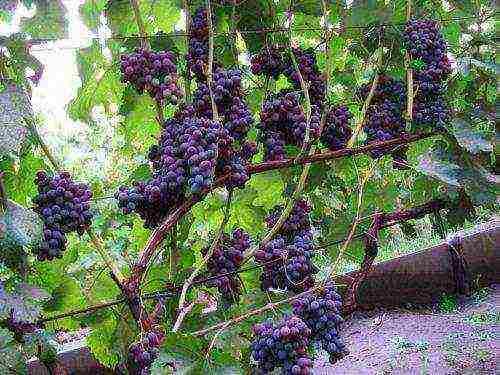
Kishmish Jupiter produces large berries, but small clusters
Kishmish Novocherkassky
The advantages of this variety, which need to be highlighted by examining its description:
- tolerates frost;
- stable harvest;
- high resistance to fungal diseases;
- not afraid of diseases.
Taking them into account, it must be said that the plant requires certain care: a garter of the vine, timely planting, shelter for the winter, in order to preserve the bushes, because the plant bears fruit only in the second or third year after planting. Berries ripen for 140-150 days.
This type of grape on the shelves has a significant advantage over other types, since it does not have seeds or there are few of them. What is important in cooking, in the manufacture of desserts, dishes.

Kishmish Novocherkassky - frost-resistant variety
Useful properties of grapes
The vitamins that make up the fruit act on the nervous system and help relieve stress, it acts as a mild sedative. It also contains ascorbic acid, which strengthens the immune system and protects the body. Potassium, which is part of the composition, helps to prevent the development of heart disease, therefore, people suffering from vegetative-vascular dystonia and hypertension, arrhythmia need to use this grape variety.
Grapes also contain boron, which reduces the possibility of developing osteoporosis. For teeth, grapes (certain parts of the plant) are useful, thanks to the oleanic acid contained in the composition, it reduces the occurrence of caries and gum disease.
Contraindications are also present:
- It is not recommended to use in case of diabetes mellitus.
- For stomach ulcers, it is strongly discouraged.
- Grapes destroy tooth enamel, so after eating you need to rinse your mouth.
To avoid an excess of vitamins, you have to monitor the amount of food eaten.
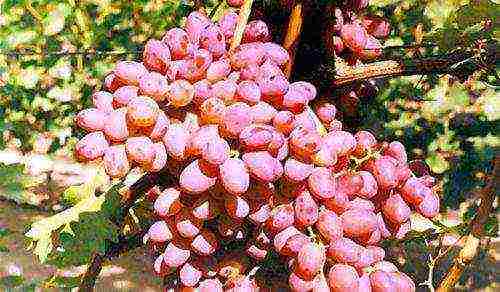
Kishmish Nakhodka, like other grape varieties, is contraindicated for diabetics.
The use of grapes in medicine
In the old days, there were references to medicinal qualities. Healers used parts of the plant to heal wounds with pus in warriors. Many skin problems can be cured by grapes. For example, grape leaves can be used for purulent wounds, nosebleeds, but before that, they have to be washed, dried and crushed.
For acne (acne) grape juice will help. Within 20 days, drink a couple of tablespoons of the product in the morning.
For skin problems - use an infusion of grape leaf platinum: grind them in a weight of 50 g and brew 750 g of hot water, simmer in a steam bath for about 15 minutes, cool and start applying as compresses.
A mixture of 20 g of berries and 20 g of aloe will save you from ringworm. Chop the berries and pour over the juice, and process the damaged areas with the resulting mixture.
Grape leaves, a small amount of wine (pure grape) and lye will save you from eczema. first rub the areas with alkali, and then apply a compress with soaked leaves in a wine liquid.
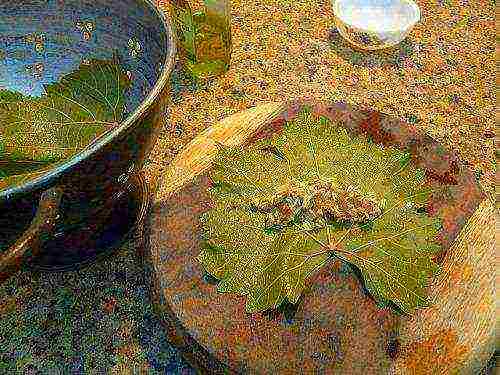
Dishes from grape leaves will help to defeat skin diseases
Classification of raisins plant varieties
All varieties are divided into seedless classes:
1st grade: Seeds are absent or small, and are not felt when eaten.
Grade 4: Has large seeds, which baffles people who do not know such a feature of this species.
Despite the fact that 3-4 varieties are in low demand, breeders create new types of these plants, based on the fact that there is an opportunity to bring out the best qualities and properties in one plant.
Grape seed oil
Since in some types of grapes there are large seeds - seeds, a useful composition is easily squeezed out of them. The seeds contain no less nutrients than the berries themselves. This oil has a positive effect on the treatment of certain diseases. But, there are some subtleties, as biological substances retain their properties during cold pressing.
Grape oil is considered the best natural antioxidant for improving the elasticity of blood vessels. Also, the composition lowers the level of cholesterol in the blood, and is used in the initial stages of hypertension. Applying a spoonful of oil every day will reduce the likelihood of arthritis, heart and blood vessel diseases, boost immunity, and increase protection against infections. Healing oil prevents heart attacks, strokes, thrombosis. And if you combine oil with therapy, then a quick recovery will come. This remedy also has a regenerating effect, improves skin elasticity, helps with the healing of wounds, abrasions, cuts.
Indications for the use of grape seed oil are problems with the digestive system, hepatitis, biliary tract.
This oil is easy to make at home and is based on the principle of oil diffusion or displacement. The recipe is simple:
Rinse and dry the bones. Dry in the oven at 40-45 ° C. Then grind in a coffee grinder or with a blender. Fill a jar with a volume of half a liter, seal and fill with refined sunflower oil. As the seeds are absorbed, the oil should be added. Close the dishes tightly and refrigerate for a week, stir occasionally. After the expiration date, squeeze the bones through two layers of gauze and put back in the refrigerator. Do not shake the greenish oil collected from above, pour into a bottle.
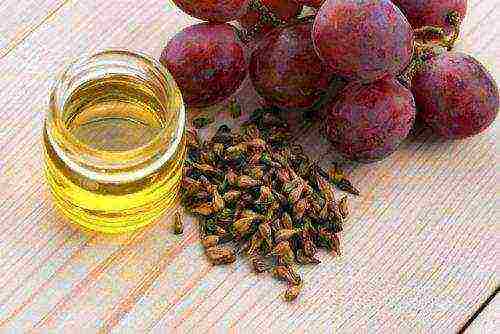
Grape seed oil can be made at home
Wine from the grape variety
An extensive use of grapes is the manufacture of alcoholic beverages. The wines produced with its addition have exquisite taste characteristics and are quickly disassembled on supermarket shelves.Wine production technologies have their own characteristics, thanks to which products are born that are distinguished by smell, captivating aroma and sour taste.
The raisin grape variety is popular and is used in the following spheres of life: in cooking, winemaking, treatment, thanks to beneficial substances. Grapes are filled with vitamins that help muscles work, normalize the functioning of the digestive system, relieve fatigue and tension. Grapes are used in the creation of medicines, winemaking and cooking. Some unpretentious varieties are allowed to grow in your country house, the main thing is to provide proper care and fertilization with nutrients.
Subscribe Be aware of new products on our site
Kishmish grapes came from the East. The first seedless varieties appeared in Central Asia as a result of natural mutation. In Arabic, qish mish is dried grapes. All varieties of this type contain a large amount of sugar. Many people prefer raisins to other grape varieties for their dessert taste and lack of seeds.
Description of the best varieties with photos
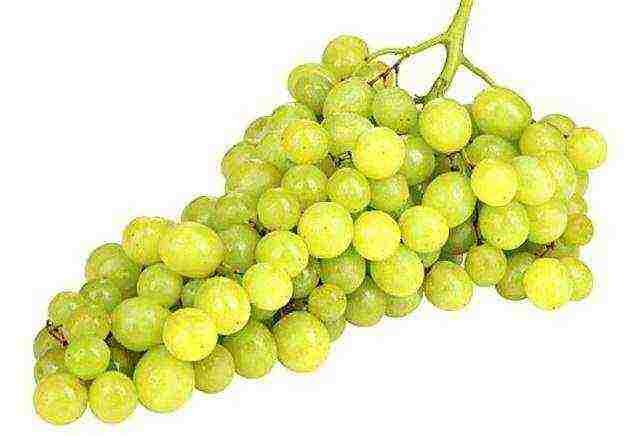 Ripe bunch of Kishmish variety
Ripe bunch of Kishmish variety
The climate in our country is harsh. Previously, grapes were grown only in the south. Now, thanks to breeding work, varieties with early ripening of fruits, resistant to Russian frosts, have been obtained. Gardeners of the Urals and Southern Siberia successfully breed them on their backyard plots.
All new varieties are hybrids, there are many of them. You can always pick up a variety of raisins that winters well and matures during the short summer. Consider the popular varieties of raisins:
- Kishmish No. 342.
- Radiant kishmish.
- Einset Seedless.
- Rusbol.
- Jupiter.
Kishmish No. 342
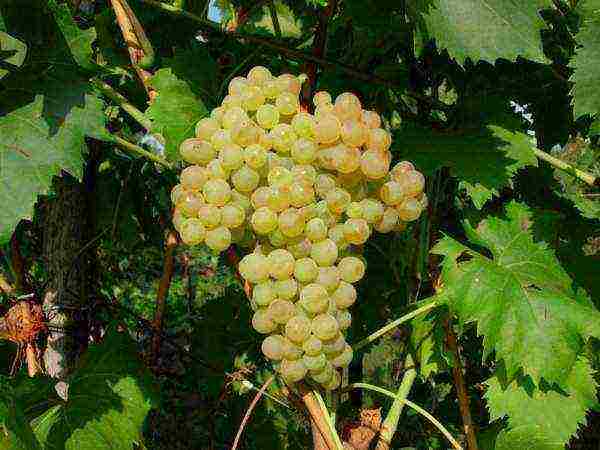 Bunch of varieties K. No. 342
Bunch of varieties K. No. 342
Variety K. No. 342 can be grown in the middle lane, as it tolerates frosts well down to -26 ° C. K. # 342 has been very popular for many years. It is often called Hungarian kishmish. Ripens early, within 110 days. K. No. 342 - vigorous plant.
Large clusters weighing up to 500 g. Golden-green berries weighing about 3 g are of medium size. There are no rudiments (seeds). The pleasant, dessert taste of the pulp surprises with its sweetness and juiciness. The berries are grown for drying and table consumption.
Rusball
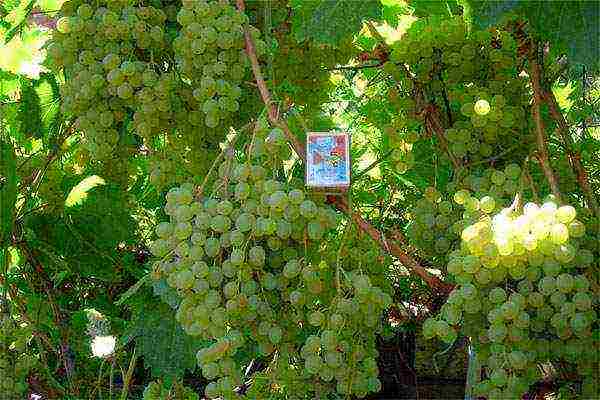 Medium dining room Rusbol on the garden plot
Medium dining room Rusbol on the garden plot
Table variety Rusbol, early - Russian breeding raisins. The crop is harvested in 105-115 days. The plant is tall. On powerful lashes, clusters weighing from 600 g to 1.5 kg are formed. The density of the brushes is medium, the shape is conical.
The shape of the berries is oval, color is white, weight is from 2.5 g. The flesh of Rusbol is dense, with a harmonious combination of sweetness and sourness, juicy. Fruiting begins at 2 years. The variety responds well to fertilizing with potassium-phosphorus fertilizers. Grows best on vigorous rootstocks.
Kishmish Radiant
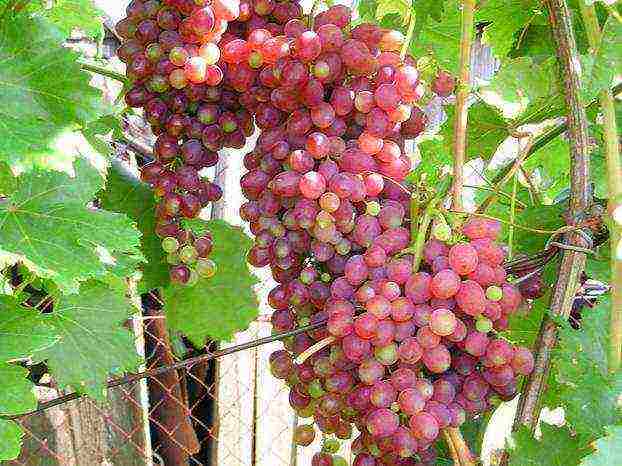 A bunch of varieties Radiant
A bunch of varieties Radiant
Radiant is a favorite raisin variety. It is considered the sweetest of the seedless varieties. Radiant Kishmish consistently gives good yields. It belongs to the medium early varieties (125 days), the harvest is harvested before September 1. Spreading bushes, medium height.
The berries are medium or large (2.5-4 g), collected in long 40-45 cm conical clusters weighing from 600 g to 1 kg (1.5 kg). The pulp is crispy, dense, juicy, sweet and sour with the taste and aroma of nutmeg. The skin is pink.
Radiant kishmish does not differ in high frost resistance (-15 ° С), therefore, even in the south, it is recommended to cover it for the frost period. High yields are possible with good agricultural technology, which is within the power of a competent winegrower.
Jupiter
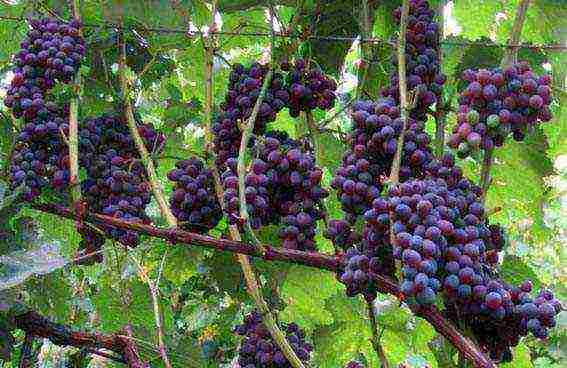 Ripe Jupiter Sidliss
Ripe Jupiter Sidliss
Kishmish Jupiter is an early variety (105-120 days), bred in North America. It is distinguished by high productivity. Medium-sized bushes begin to bear fruit 2-3 years after planting.
The bunches are formed with a mass of 200 to 250 g. The shape of the brushes is cylindrical. Berries are oval, large (4-7 g), may have rudiments.The peel is pink, sometimes red, in ripe berries it is dark blue, strong, not subject to cracking.
The pulp with nutmeg flavor, juicy, firm, sweet. Kishmish Jupiter has good winter hardiness (-27 ° C), resistance to fungal infections. The variety is appreciated for its high yield - 250 c / ha.
Ainset Seedlis
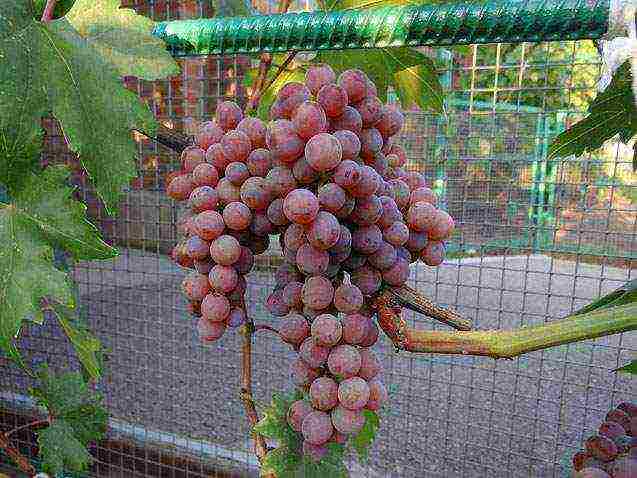 Ainset sidlis in the vineyard
Ainset sidlis in the vineyard
A descendant of Isabella, the Ainset sidlis variety, bred in the USA, is early in terms of ripening. It is distinguished by good frost resistance (down to -27 ° C). The bush is powerful, tall. The clusters are dense, conical, small in size, the average weight of the hand is about 250 g.
Small (2-3 g), pink or bright red oval-shaped berries are covered with a dense skin, which is easily removable, does not crack. The juicy pulp is very fragrant and can be recognized by the characteristic strawberry scent of isabella. Berries can be dried and consumed fresh. They are easy to transport. Stored well for 2-3 months.
Advantages and disadvantages
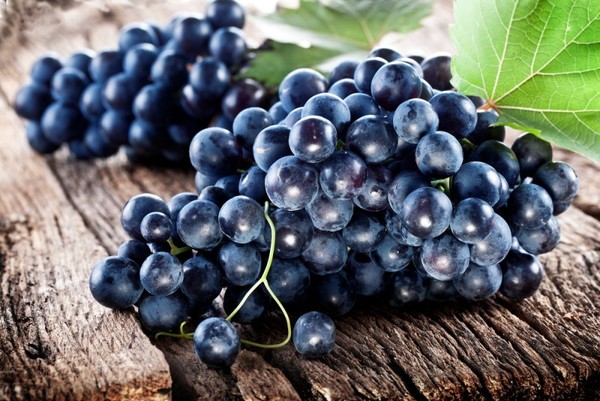 Table Kishmish
Table Kishmish
The table shows the advantages of the varieties described above.
| Variety | Frost resistance | Attitude to disease | Transportability | Usage |
| K. No. 342 | -26 ° C | the variety is resistant to fungal diseases | good | fresh, drying |
| Rusball | -25 ° C (no shelter required) | immunity to mildew, gray mold | good | fresh, drying |
| K. radiant | low (-15 ° C), requires shelter for the winter | unstable | good | wine, compotes, fresh consumption |
| Jupiter | -27 ° C | medium resistance to fungal diseases, preventive treatments are needed | good | fresh, drying |
| Ainset Seedlis | -27 ° C | immunity to mildew, gray mold | good | fresh, drying |
Each variety has disadvantages. For example, raisins No. 342 need shelter in winter, it crumbles if the bunches are not cut off in time. The disadvantages of Rusbol include high yield. If you do not carry out rationing of the crop, the bushes can break from severity. The presence of rudiments is another drawback of Rusbol raisins.
Small clusters and brittle branches are the disadvantages of Jupiter raisins. For raisins, a radiant drawback is a high yield, exactingness to agricultural technology. The variety requires rationing of ovaries.
Features of planting and care
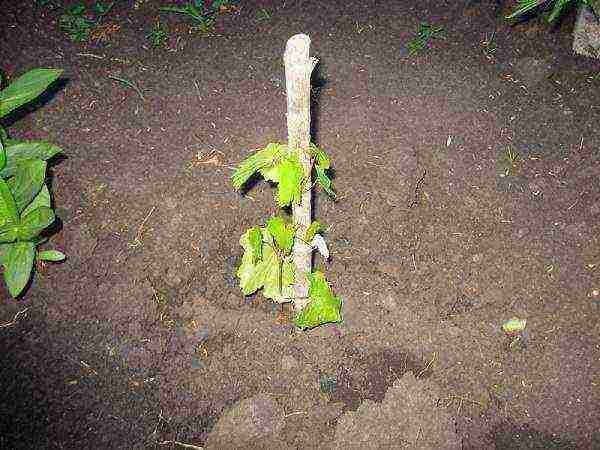 Young seedling in soil
Young seedling in soil
Successful cultivation of raisins begins with the selection of a variety that, in terms of its characteristics, is suitable for specific climatic conditions. In addition, a novice grower should seriously approach the choice of a place, planting technology and subsequent care. In addition, the timing of planting is important.
In the south, planting raisins is best done in autumn. The right time is the first decade of October. So that the young plant does not suffer from winter frosts, it is sprinkled with earth and covered with non-woven material folded in several layers.
In the middle lane and in the northern regions, raisins are planted in the spring (April, May). Planting can be carried out when the soil warms up to 12 °. You need to have time to plant raisins before the buds have blossomed. For those who purchased raisins grown in a container, it is easier. They can plant grapes in June.
Grapes grow well in higher elevations, but not every garden plot has them. The southern or southwestern part of the garden will do. It is good if from the north the plantings are protected from the wind by a wall or hedge. Main conditions:
- good lighting;
- lack of wind and drafts;
- distance of 3 m to other plants (trees, bushes) and buildings.
Landing
 Greenhouse seedlings before planting
Greenhouse seedlings before planting
Before proceeding with planting and digging a hole, you need to prepare:
- Drainage (broken brick, crushed stone, gravel).
- Support count.
- Mineral fertilizers (superphosphate).
- Humus.
- Ashes.
Dig a planting hole 70 cm deep and 70 cm wide. Pour a 25 cm layer of drainage at the bottom. Add 2-3 buckets of humus, a glass of superphosphate and ½ a bucket of ash to the garden soil, which will be backfilled.
Drive a stake into the center of the hole, fill in the prepared soil and form a hole for the seedling in it.It should be so deep that only 2 eyes stick out above the ground. The landing pit is filled with water. The growing shoots must be tied to a support.
Care
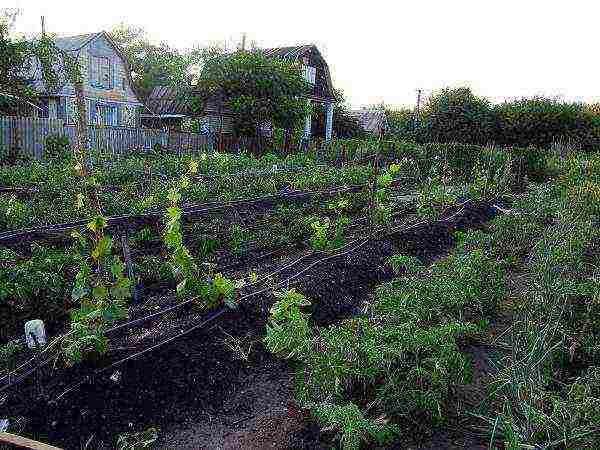 A row of the Radiant variety in the garden
A row of the Radiant variety in the garden
Pruning... An important point in caring for grapes. The yield and health of the vine depends on how competently it is carried out. The norm of eyes on the vine is from 8 to 12, excess shoots must be cut off. Cut out weak branches. Carry out rationing - leave 1-2 clusters on each shoot.
Watering... If the weather is hot, water the raisins every 3 days. One plant needs at least 4 buckets of water, more water is needed if the soil is sandy. 2 weeks before harvesting, water once every 7 days.
Top dressing... In the spring and in the first half of summer, grapes need fertilizing containing nitrogen, and organic fertilizers will not interfere. In the second half of summer, the plant needs potassium and phosphorus to form fruit. Nitrogen feeding is stopped.
In addition to root dressing with mineral and organic fertilizers, foliar dressings are needed. Carry out them during the flowering period of grapes. Use the drug Ovary. Apply a gibberellin stimulant to increase the size of the berries and increase the density of the bunch.
Diseases and pests
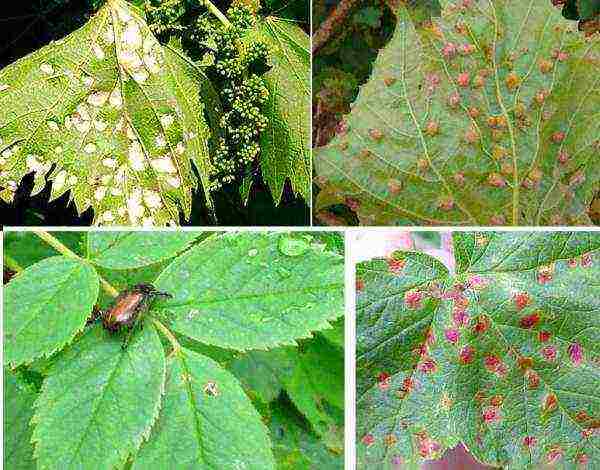 Leaf disease Kishmish
Leaf disease Kishmish
Vine plantations often suffer from fungal infections. For their prevention several times per season, it is necessary to process the bushes. Copper sulfate and Bordeaux liquid should be used in early spring and autumn after harvest.
In summer, it is better to use complex preparations for processing:
- Ridomil Gold;
- Strobe.
When white bloom appears on the leaves and stems of the raisins (symptoms of powdery mildew), treat the grapes with Topaz.
Insecticides may be needed if spider mites or other pests attack the raisins. In the summer, the crop often suffers from wasps. To protect the berries from them, the vineyard is fumigated with smoke or special bags are put on the bunches.
Kishmish grapes: video
Reviews
Svetlana (Rostov region)
I recommend growing Ainset Seedlis grapes. This is a very worthy variety. In our conditions, it ripens in early August. Can be left on the bushes. The grapes do not lose their flavor. We make dessert wine from it, dry it. The harvest is big, enough for everything. There are no problems with this variety. It tolerates frost well, does not get sick.
Alexander (Oryol)
Kishmish No. 342 ripens in early August. Children are delighted with him. The berries are small but very sweet. The bushes are powerful, do not get sick. I do the treatment twice for prevention. I want to plant two more vines for drying on raisins.
Gregory. (Novoaleksandrovsk)
We grow Rusbol. The bushes are tall, powerful, and productive. I like the taste, harmonious. The berries are medium rather than large. The color is white, the taste is sweet. The average weight of a bunch is 400 g.
Vladimir (Belgorod)
Jupiter is considered the best seedless grape. I have about 60 bushes growing. I successfully trade it on the market. Satisfied with everything: yield, frost resistance, taste, appearance, lack of cracks on ripe berries. I do not consider small bunches to be a disadvantage.
Igor (Voronezh)
I successfully grow Radiant raisins. I think that in terms of taste, this is one of the best varieties. The bunches grow large, marketable.
Most green grape varieties are simply excellent in taste. That is why they are truly immensely popular with summer residents. In particular, raisins of green grapes taste good. Several of them have been bred in recent decades. For example, gardeners often grow a very well-proven variety of raisins "century".
How and where was the variety obtained
It was bred by American breeders. The work was carried out at the Davis experimental station and was practically finished already in 1966. However, the “century” raisin was registered as a variety only in the 80th year. It is precisely because it was entered into the registers at the end of the century that it received such a name.When developing this grape, experts used such varieties as Gold and Q25-6.
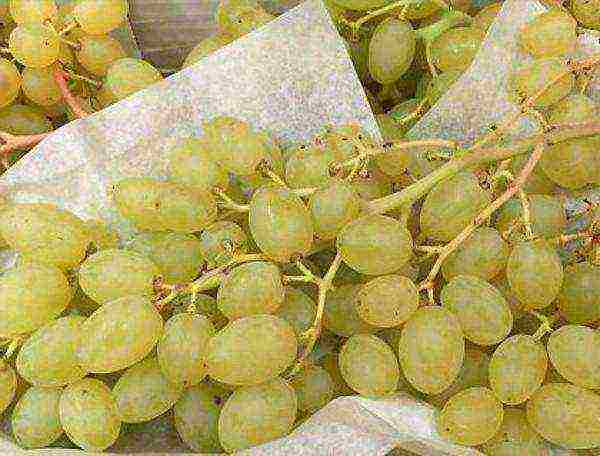
General description
This grape, as already mentioned, belongs to the group of seedless. Its developers position it as a canteen. Powerful lush bushes - this is what, among other things, distinguishes the raisins "century". The photos presented in the article demonstrate the good strength of this variety clearly. Gardeners estimate the grape yield as average. The bunches on the vines of this variety ripen rather late. You can harvest the "century" around the first or second decade of September.
According to many summer residents, this rather tested and well-proven variety is quite resistant to diseases. It practically does not become infected with a fungus. However, prophylactic treatments of the vines of the "century" should be done by summer residents (2-3 times per season).
This variety belongs to the class of frost-resistant. But he still cannot withstand too low temperatures in winter. And it will be more convenient for summer residents to grow it in the rather warm southern regions of Russia. By the way, even in a relatively mild climate, this variety requires shelter for the winter. The minimum temperature that it can withstand is -25 ° C.
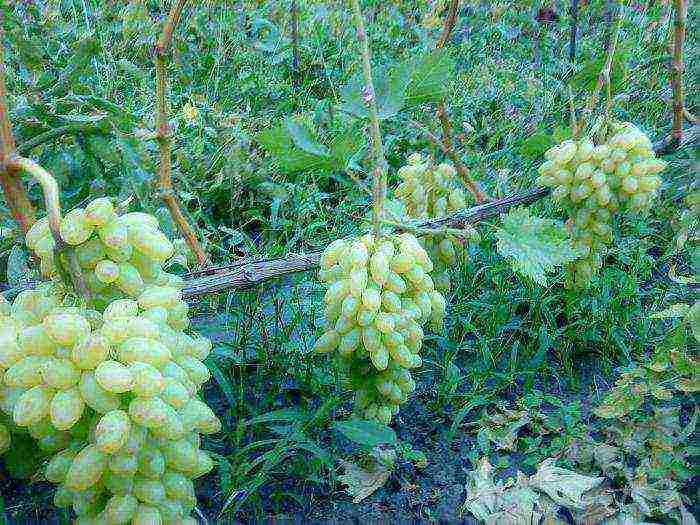
Brush varieties
The "century" refers to raisins, as already mentioned, to late table varieties. The clusters on the vines of these grapes ripen very large. Their average weight is 400 grams. Some bunches can reach a mass in 700-1200 g. The shape of the brush of the described variety has a classic conical shape. The berries in the bunches are not too densely arranged. Quite a lot of brushes grow on each bush of this grape.
Berries of the variety kishmish "century": description
The brushes of this variety are large, but the berries themselves are rather small in size. They weigh only about 8-6 grams. The berry has an oval or oval-elongated shape. And the color of the fruits of the "century" is light green with a honey tint.
Summer residents have only excellent reviews about the taste of the berries of this variety. The flesh of the fruit is very dense (even a little crispy) and juicy. It has a sweet and sour taste. Some summer residents note the fact that the berries of the "century" have, among other things, a pleasant taste of nutmeg.
Their skin is quite dense, so the berries are well-transportable and can be stored for a long time. The pluses of the fruits of this variety include the fact that they do not crumble when overripe.
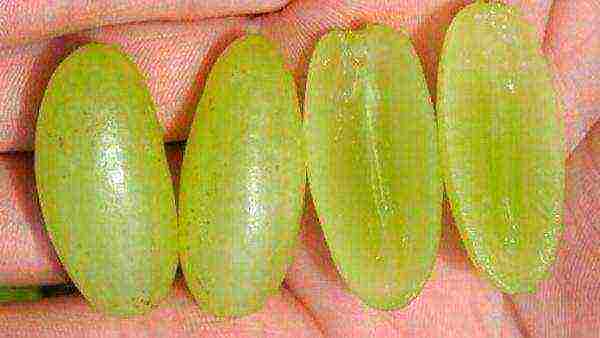
By the way, the thickness of the skin is small and it is eaten together with the pulp very easily.
The sugar content of the fruits of this variety is not too high - 13%. That is, this grape can be used, basically, just as a table one. For making wine raisins "century" is not used. It turns out that it is not very tasty from these berries. But the raisins from the fruits of this variety are just excellent.
Landing features
Thus, the described plant is quite fruitful and attractive for summer residents. Next, let's figure out how to properly plant and grow raisins "century" (a photo of its large berries with an attractive shape and color are presented in the article).
This variety is not very resistant to return frost. Therefore, it is recommended to plant it on the site no earlier than the end of April - beginning of May. A hole for planting, since the root system of grapes is just well developed, it is supposed to be made quite large - at least 70 cm deep and 80 cm in diameter.
The place for the bush should be sunny. Bushes cannot be placed too close to each other. One of the features of raisins is their love of space. Thickened plantings of the "century" will not give too good harvests.
Watering the grapes
This variety requires a lot of water in the summer. It should be watered at least twice a week. In this case, for one bush you need to use at least one and a half ten-liter buckets of water.To reduce moisture loss, it is recommended, among other things, to mulch the garden bed with straw or rotted manure.
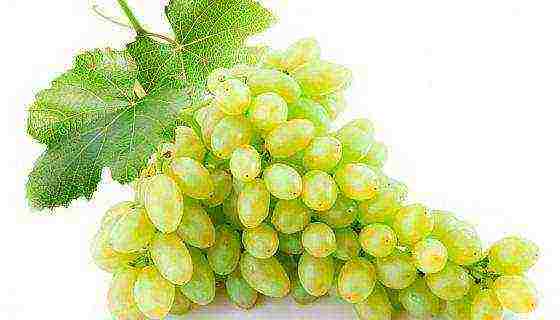
It is believed that this variety, like most other raisins, responds very well to drip irrigation. It is this method of moistening the beds under the bushes that is recommended to be used by those summer residents who come to the plots only on weekends. And overdrying these grapes is highly discouraged.
Reduce the number of waterings only starting from mid-August. During this time, excess water can cause the berries to crack. However, you should not leave the bushes dry even in August. The soil under them needs to be moistened, however, only slightly.
How to fertilize
Next, let's look at how to properly feed raisins "century". The description, the photos presented in the article, allow us to judge it as quite fruitful. However, despite the fact that quite a lot of brushes grow on the vines of this variety, they do not require too frequent feeding.
Moreover, an oversupply of fertilizer in the garden under these grapes can lead to a delay in its development. In the spring, organics are best used for the named variety. The vines can be fertilized, for example, with diluted water in a ratio of 1:10 with slurry. It is advisable to make such a top dressing simultaneously with watering.

In the middle of summer, the "century" grapes can be fertilized again. But nitrogen agents, including organics, cannot be used at this time. This can lead to a build-up of green mass in the grapes and a decrease in yields. During the formation of the brushes, it is usually fertilized with calcium and phosphorus compounds.
It is believed that it will be very useful to spray these grapes with the "Ovary" stimulant. Using this tool allows you to get somewhat larger berries in the "century" brushes. The vines are sprayed with a stimulant during flowering.
Pruning bushes
Among summer residents, grape raisins "century" have earned excellent reviews, including for the good strength of the bushes. But it should be noted that the bunches of this variety are very heavy, so the load of the vines with brushes must be normalized. For each shoot, experienced summer residents recommend leaving no more than 1-2 bunches. The rest should be removed. Pruning of grapes is carried out according to the technology provided for all raisins. That is, 8-12 buds are left on the branch.
Protection against fungus and other diseases
Spraying grapes "century", in order to prevent infection with fungal diseases, is usually carried out using Bordeaux liquid 5%. This composition is used in the spring. In summer, vines can be treated with Strobi or Ridomil Gold.

Sometimes the described grapes, like any other varieties of this horticultural culture, are infected with a spider mite. To get rid of plants from this parasite, the use of any garden insecticide is allowed.
The opinion of summer residents about the variety
The gardeners' reviews of raisins grapes "century", as we have already said, are relatively good. So, many raisins of this culture have rudiments of seeds in the berries. And in hot weather, the latter are even able to significantly increase in size. Grapes "century" are completely devoid of this disadvantage. There are no rudiments in its fruits at all. That is why it is believed that it is just great for making raisins.
The pulp of the berries, according to summer residents, is actually very tasty - not cloying and at the same time not too sour. In addition, the fruits, judging by the gardeners' reviews, do not smell like medicine at all, as is often the case with foreign varieties. Another plus of grapes "century" is that the gardener does not need to rush to harvest. Brushes of this variety can sag on the vines, without crumbling at all, until the very frost.
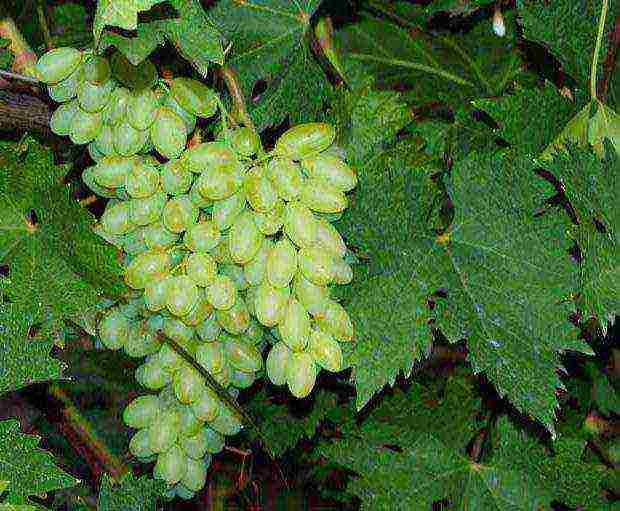
Instead of a conclusion
So, in this article we have found out what the "century" table grapes are.Description of the variety, photo, we hope, helped you to form an opinion about these berries. With regard to watering and low temperatures, these plants, as you can see, are quite whimsical. However, in all other respects the raisins "century" are absolutely undemanding. So, of course, summer residents of the southern regions should not refuse to buy these vines.

